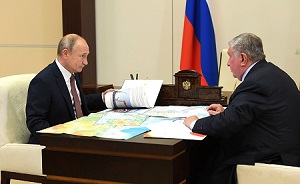Igor Sechin Reports to President on Implementation of Promising Projects Vostok Oil and Zvezda Shipyard
-350x1000.jpg)
 |
| Photo Credit: Press Service of the President of Russia |
Vladimir Putin has held a working meeting with Rosneft Oil Company Chief Executive Officer Igor Sechin. The main topics were promising projects implemented by the Company: Vostok Oil in the north of the Krasnoyarsk Territory and the Zvezda Shipbuilding Complex in the Far East.
The head of Rosneft thanked the President for supporting the Vostok Oil project and for the investment benefits provided for the development of infrastructure. As Sechin noted, it allowed to create an economically effective model and to start the practical implementation of the Project. Rosneft has pledged to deliver up to 30 million tonnes of oil to the Northern Sea Route by 2024.
Igor Sechin reported that exploration work is being conducted to prepare the resource portfolio of Vostok Oil. The priority sites for multiple well pads have been identified; there will be up to 150 of them at the initial stage. A site for oil recovery and treatment units is being prepared. The survey and design stage of the project to build a pipeline, which will be 770 kilometres long, and a port in Sever Bay have been finished. These projects will ensure the production, transportation and transhipment of up to 50 million tonnes of oil a year at the initial stage, and up to 100 million tonnes when the second stage is completed.
To meet the energy needs of the Project, Rosneft signed a contract with Inter RAO for a set of works to design and construct energy facilities, including energy centres with a total capacity of 2,500 GW, as well as more than 3,500 kilometres of power lines.
As the head of Rosneft noted, Vostok Oil will generate extensive synergy in Russian industrial production. To ship oil produced by this project, an order for 10 Arc7 ice-class tankers have been placed at the Zvezda Shipbuilding Complex. In total, there will be 50 vessels of different types servicing the Project, including tankers, gas carriers and supply vessels.
In the interests of Vostok Oil, a long-term contract was signed on delivering up to 100 drilling units produced in Russia. These machines are equipped with modern geolocation and geosteering systems that can be bound to a specific drilling point. They stand on a hydraulic platform, which ensures more precise drilling, greater drilling speed, higher efficiency and less risk of accidents. The drilling unit has a modular structure. Thanks to its compact size, it is almost half the size of a regular drilling rig; therefore, the investment cost of a well cluster will be 30% lower. It is an Arctic-type drilling unit with wind protection. The unit has already been tested during the drilling the 31st well in the West Irkinskoye area.
Igor Sechin informed the President that the work to provide the Project with the equipment continues. In particular, the long-term supply contract with KAMAZ for the supply of machinery, special-purpose equipment and the establishment of specialised maintenance centres has been extended. At the first stage, the Project will require 2,500 pieces of machinery, special-purpose equipment and cranes. Subsequently, the total quantity may increase to 6,000 units.
The possibility of procuring helicopters for the Vostok Oil project was discussed with Rostec. Considering the fleet the Company already has, around 50 new helicopters will be required at the first stage.
To meet the needs of the Project, negotiations are underway for the supply of 6 million tonnes of pipe of different diameters, both for mains and for infield pipelines as well as drill pipes and casing. This will increase the workload for our metal companies and pipe producers by over 20%.
The Project is to create tens of thousands of new jobs. It will take over 400,000 people to develop the Vostok Oil fields, including 130,000 Rosneft personnel and contractors. Fifteen new towns will be built to accommodate workers who will stay there in shifts.
Answering the President’s question about the progress of work at the Zvezda Shipbuilding Complex, the head of Rosneft emphasized that this is not only the most modern shipyard in Russia but also an entire manufacturing complex. Igor Sechin reported Vladimir Putin on the completion of the construction of the dry dock, one of the key facilities of Zvezda. This unique hydraulic facility is currently at the pre-commissioning stage.
The length of the dry dock is 485 metres, width 114 metres, depth 14 metres. President noted that it is the largest dry dock. Currently, casting concrete for the dock’s walls and the bottom has been completed and work on the service gallery is being completed. Work is in progress to install equipment for the main structure of the dock – the main pump station. The Goliath crane with a capacity of 1,200 tonnes (the second one at the shipyard) has been assembled. Tower cranes have been manufactured and delivered to the shipyard, and a caisson for floating out finished vessels has been installed.
Right now, 53 orders are in progress at the shipyard. These are state-of-the-art vessels, predominantly of a high ice-class: supply vessels, research ships, icebreakers, Arctic shuttles, green Aframax tankers, gas carriers. The icebreaker Leader is laid down at the shipyard. It is a unique icebreaker. It will lead a convoy of vessels and provide year-round loading for the Northern Sea Route.
Igor Sechin reported on the progress of the President’s order to provide the Zvezda Shipbuilding Complex with sheet steel. A site has been selected at Sukhodol harbour, next to Bolshoy Kamen, for the construction of a steel mill with a capacity of 1.5 million tonnes of sheet steel and pipes. The shipyard’s full metalworking capacity is about 330–350 thousand tonnes per year, and the rest of the products will be in demand by other regional companies.
Rosneft
Information Division
November 25, 2020